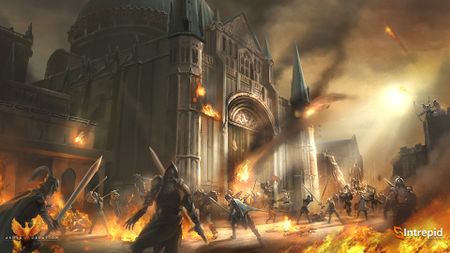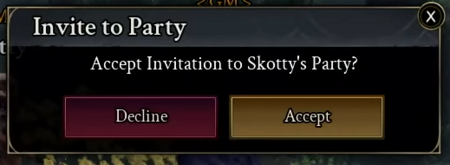Afiliações
Uma árvore de afiliações determina quais entidades podem participar em ataques contra outras entidades dentro de sua hierarquia. [1][2]
- Node citizenship.[1][2]
- Alliances.[1][2]
- Guildas.[1][2]
- Parties.[1][2]
- Raids.[1][2]
- Family.[1]
- Religion.[2]
- Society.[2]
There's node citizenship. There's guild. There's alliance. There's party. There's raid. There's family. All of these types of affiliations have a hierarchy. The highest of which is your node affiliation: So your citizenship is your greatest superceding relationship, which means if you were a part of a guild and the guild has multiple nodes in which its members are citizens of, if there was a war between two of those nodes, the members of those nodes would be first and foremost citizens who defend that node, even against their own guild members.[1] – Steven Sharif
All of these things have some hierarchy; and within that hierarchy there's the ability to participate within certain systems. So for example, if you have a node that has fallen under your vassal state and you're a citizen of the parent node, then you could participate in a siege against the vassal node but if you're a citizen of the vassal node you could not participate as an attacker against the parent node; so there's a hierarchy, unless you were to renounce your citizenship.[2] – Steven Sharif
Dinâmicas de grupo
Dinâmicas de grupo aim to bring players together.[4]
- One of the main philosophical pillars behind our design was that PvE must be impactful and inclusive. We want solo players, small groups and large groups to all have a home within our system.[5]
- Ashes of Creation is in development. These systems could change through playtesting and player feedback.[4]
Group sizes

The minimum goal is 500 players on a single battlefield. I think we will be able to hit 500vs500 but we shall see.[6] – Steven Sharif
Ashes of Creation foi concebido para jogadores a solo, bem como para grupos grandes e pequenos.[7][8]
- O tamanho de um grupo é de até oito (8) jogadores em um único grupo.[4]
- Raids terão grupos de 40 jogadores.[9]
- O conteúdo será adaptado para grupos de 40, 16 e 8 jogadores.[10]
- As arenas terão 1x1, 3x3, 5x5 e possivelmente um Free-For-All de 20x20 (Deathmatch).[11]
- Não haverão especificamente arenas de guilda vs guilda porém, um matchmaking baseado em equipas, permitirá um grupo enfrentar outro grupo.[12]
- Espera-se que os Cercos de castelo tenham no mínimo 250x250 jogadores num único campo de batalha, com a possibilidade de aumentar este número para 500x500 ao longo do tempo.[13][14][15][6]
A ideia por detrás de um grupo de 8 pessoas é permitir-nos realmente ampliar as funções do grupo, e criar uma necessidade para cada um dos modelos em cada grupo.[4]
O conteúdo não é apenas exclusivo para guildas.[16]
- Existem mecânicas dentro de conflitos maiores para que pequenos grupos e até jogadores a solo tenham impacto na batalha.[17]
- Isto inclui sistemas que provavelmente se concentrarão em participantes de tamanho de grupo único enquanto a batalha maior ocorre.[17]
Intuitive grouping
There are systems such as quests, events and monster coins that lend themselves toward intuitive grouping, but no specific decision has been made to include this functionality.[18]
Ver também
Referências
- ↑ 1.0 1.1 1.2 1.3 1.4 1.5 1.6 1.7 Transmissão ao vivo, 2019-03-29 (17:10).
- ↑ 2.0 2.1 2.2 2.3 2.4 2.5 2.6 2.7 2.8 Entrevista, 2018-05-11 (58:07).
- ↑ Vídeo, 2024-02-29 (19:35).
- ↑ 4.0 4.1 4.2 4.3 Group dynamics blog.
- ↑ About Ashes of Creation.
- ↑ 6.0 6.1

- ↑ Transmissão ao vivo, 2020-11-30 (1:20:25).
- ↑

- ↑ Transmissão ao vivo, 2017-05-09 (34:38).
- ↑ February 8, 2019 - Questions and Answers.
- ↑

- ↑ Transmissão ao vivo, 2017-05-26 (48:12).
- ↑ Transmissão ao vivo, 2021-09-24 (52:48).
- ↑ Entrevista, 2021-07-08 (57:19).
- ↑ Entrevista, 2020-07-19 (44:28).
- ↑ Transmissão ao vivo, 2017-05-08 (28:48).
- ↑ 17.0 17.1

- ↑ Transmissão ao vivo, 2017-05-15 (29:30).
